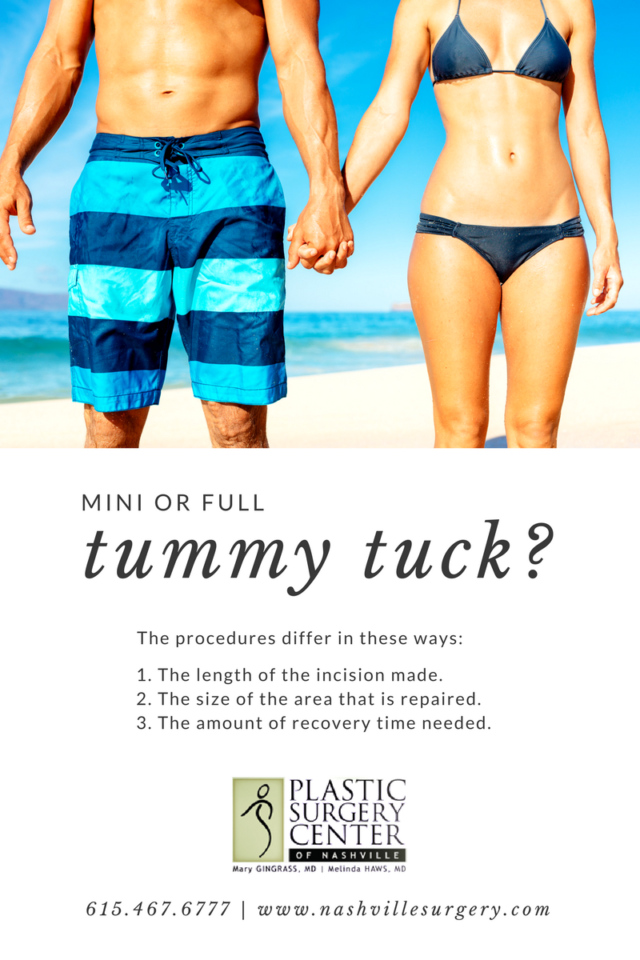A flabby-looking stomach isn’t always caused by excess fat. If you’ve recently lost a lot of weight or given birth, you may be suffering from damaged abdominal muscles and an accumulation of loose skin. If this is the case, abdominoplasty (also known as tummy tuck surgery) can repair your muscles and give you a flat, taut belly. Note that tummy tuck surgery is the only way to correct these issues; diet and exercise alone cannot.

When considering tummy tuck surgery, it’s important to know that there are two types of abdominoplasty available: Full and mini. A mini tummy tuck is sometimes also referred to as being a partial abdominoplasty. These procedures differ in these following ways:
- The length of the incision made.
Full tummy tuck surgery requires the cutting of a very long incision; it runs from hip to hip, usually along the bikini line. Often the surgeon will make a second incision around the bellybutton as well, in order to correct skin laxity on both the upper and lower abdomen. Conversely, during a mini tummy tuck, just one short incision is made above the groin. The scar that results from mini tummy tuck surgery is therefore much easier to hide than the scar produced by a full tummy tuck. Note, however, that you can minimize the risk of scarring with full abdominoplasty by choosing an experienced plastic surgeon. A skilled surgeon will deftly hide the upper incision scar within the confines of the bellybutton so that it’s hardly noticeable. He or she will place the lower incision where it can be hidden by your underwear for maximum privacy. He or she will also make sure it’s only as long as it absolutely has to be.
- The size of the area that is repaired.
While most patients immediately wish to choose the procedure that offers the lowest risk of scarring, it’s important to first consider your individual needs. Because a mini tummy tuck allows for just one relatively short incision, the surgeon has a limited area to work in. He or she will only be able to resect loose skin that is found on your lower abdomen; nothing above your belly button will be altered. This is sufficient if, for example, you’re a young woman who has had one or two pregnancies and who has little or no abdominal muscle damage. If, on the other hand, you’re an older person with a history of clinical obesity and have significant muscle damage, a mini tummy tuck will produce underwhelming results.
The easiest way to guess whether you need a full or mini tummy tuck is to look at the condition of your upper abdomen: Is it still relatively firm, with few stretch marks? Is your belly button still where it should be, with no loose skin around it? If you answered “Yes” to these questions, you can probably choose a mini tummy tuck. Only a board certified plastic surgeon can give you a firm answer on which procedure you will need to have.
Note that it is generally possible to combine liposuction with either of these procedures, so if you have deposits of stubborn fat, ask your surgeon about this option. Liposuction can often enhance the final results of abdominoplasty by creating an even sleeker appearance. If you do decide to get a mini tummy tuck, liposuction may boost its aesthetic impact.
- The amount of recovery time needed.
Full abdominoplasty is known for requiring a lengthy healing period (patients usually spend two to three weeks resting in bed, with total recovery occurring only after two months). Patients who have a partial abdominoplasty, on the other hand, are usually back to work within just one week. Complete recovery from a mini tummy tuck usually happens within three to four weeks.
Recovery from full abdominoplasty is often more uncomfortable, too. Unless you opt for what is known as a drainless tummy tuck, you will have to wear surgical drains for a period after your surgery. The drains are needed to collect excess fluid created by the body’s natural healing process. Not only do these drains require regular emptying, they can be “tugged” on accidentally when you move around. This can result in pain flare-ups.
To determine which procedure is right for you, your surgeon will need to manually assess the overall looseness of your abdominal tissue. He or she will also need to examine the condition of your muscles thoroughly. Obviously, all of this needs to be done in-office, so you will have to book a consultation in order to determine whether a full or mini tummy tuck is your best choice. Regardless of which procedure you need, selecting a highly-qualified surgeon will ensure you have a safe and successful surgical experience.
